 Written by Mike Price, OT
Written by Mike Price, OT
“Age-at-home” is a growing movement among seniors and caretakers alike. The feeling that no other place will feel like home is common for older adults who are getting ready to make a choice about assisted living arrangements. Fortunately, with a little help, many seniors can live independent, fulfilling, and even active lives all while remaining in their homes.
One of the biggest challenges to this is definitely mobility. Unlike residential treatment facilities, most homes are not designed to accommodate individuals with mobility restrictions. Sometimes tight corners, steep stairs, or even cumbersome furniture can pose an almost insurmountable obstacle.
That’s where Bestcare LLC steps in. Since the early 1990’s, patient transfer and mobility solutions have been their primary focus. Safety, comfort, and affordability are Bestcare’s primary values-- and they can boast ISO 9001 and ISO 13485 manufacturing compliance. Bestcare builds transfer solutions to last-- so that you and your loved ones can live the best years in your favorite place: home.
| Ceiling Mounted Lift System for Bedroom or Bathroom by Bestcare View Product |
One of the first places you might consider employing a transfer device or lift is in the bedroom. Getting into and out of bed can be a big source of strain on the lower body as well as a potential fall risk scenario. In institutional settings, being mobilized early with the use of lifts has been shown to improve patient outcomes.
There are several types of lifts to consider here, but a ceiling-mounted lift works well as a permanent installation. Certified installers should be present for set-up and to answer any questions.
This type of lift is great for use in the home because, unlike a Hoyer or sit-to-stand lift, a ceiling lift takes up zero floor space. This makes it a must for smaller rooms where assistance is needed. By making use of an attachable harness and track run on the ceiling, this style of lift can be extremely customizable depending on the space. One idea would be to run a track from over the bed into an attached bathroom-- talk about a win for user autonomy and independence.
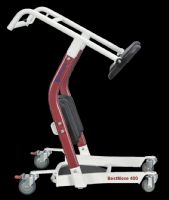 | BestMove Sit-to-Stand Active Mobile Standing Aid View Product |
What if there was a transfer lift that actually helped improve strength over time? Sit-to-Stand lifts are unique in the world of mobility aids because they have a dual purpose. They help to facilitate the transition from seated to a standing position, but they also increase core strength and independence through continued use. It is not a surprise, then, that in scientific studies the use of this type of device in training sessions was shown to speed up recovery times.
So how does it work? These powered lifts provide a brace for the seated user's legs and a handle or sling for stability during transfer. The entire device is portable and on locking casters so you can wheel it right up to a seat. By keeping the lower body secure and only elevating the upper body, the user is able to achieve an upright position without risk of a fall.
For people who still have some movement ability and core strength, this type of lift is very helpful around the house. It can be used to increase toileting autonomy without needing to adapt an existing bathroom, or simply as a tool to help you up from your favorite easy chair.
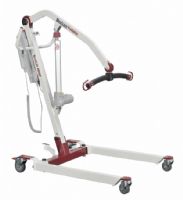 | PL400EF Electric Patient Lift by Bestcare - Foldable and Portable View Product |
Hoyer is to patient lifts as Kleenex is to tissue paper. Hoyer lifts are perhaps the most common type of mobility aid used in clinical settings. However, that does not mean that there is no place for a Hoyer in the home. These lifts are comprised of a strong hydraulic lifting arm that can be fitted with a sling, a mobile base, and a motor to power the lifting action. The full lift almost resembles a small crane.
A Hoyer doesn’t require any installation, unlike a ceiling lift, so it is more flexible in its applicable uses. That said, a traditional Hoyer-style lift can certainly be used for transfer between a bed and wheelchair, for instance. It can also be used to assist a seated user out of a chair or onto a treatment table or toileting aid.
Bestcare’s entry in this category is a fantastic model for home use. This is primarily due to its smaller-than-average footprint, which is great for maneuvering in tight spaces. Additionally, their model is foldable for storage and ease of transport. Compatibility with the most commonly available 6-point or 4-point slings ensures that your Bestcare Hoyer will be the most versatile lift you own.
While you may have known that there are different types of lifts, did you also know that you have a choice of slings? The sling is the part of the lift that actually supports and cradles the user. Slings are available in many materials and shapes -- depending on the lift you have and your individual needs it may be important to choose one over another.
Slings are differentiated based on the number of ‘points’ they connect to. A four-point sling is designed to attach at 4 places on the lift’s carry bar. There are two-point, four-point, and even six-point slings available for different purposes. Further, slings are split up based on the actual shape of the harness itself. A full-body sling, similar in shape to a hammock, can be used for patients who have very limited mobility or are immobile. U-shaped slings, designed to support the back and under the user’s legs, are often used for toileting transfer. Additionally, there are specific slings for pediatric, bariatric, and amputee needs.
With all of the options available, at-home caretakers and users aren’t the only ones who need guidance: proper sling selection has been shown to be a challenge even in hospitals. In that spirit, read on below to get more information about some common sling types.
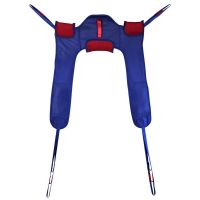 | 4-Point Sani Slings Deluxe Padded Patient Toilet Sling View Product |
Four-point slings are the most common lift sling style available. A standard Hoyer lift sling will have a four-point design with two of the ‘points’ attaching to the carry bar behind the user in the sling, and two points attaching in front. This design keeps the user’s weight distributed evenly for maximum comfort and safety.
Typically, a four-point design will create a seated-sling. In fact, probably the most common sling design in use, sometimes called the universal sling, is a four-point, seated, full-body sling used in hospitals. Full-body slings that are supinated -- for a fully reclined or prone patient -- typically require more attachment points for maximum support. Some repositioning slings have as many as 10 points.
This design is common for ceiling lifts of all types and for Hoyer lifts. Bestcare’s four-point Sani Sling is a durable piece of equipment for toileting activities. It comes in four sizes and is weight-rated up to 600lbs. The open bottom created by the u-shaped, padded material is ideal for transport into the bathroom and for sanitization and cleaning after use.
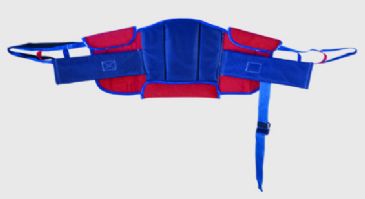 | 2-Point Stand Assist Slings and Support Straps View Product |
The ability to stand up from a chair, or conversely to sit down safely, is a large component in the autonomy of older adults and people living with disabilities. From personal hygiene tasks to social gatherings, sitting plays a role in many daily activities. Reduced range of motion, pain, and muscle weakness are several factors that can limit this complex movement. Furthermore, the risk of sustaining a fall and a possible bone fracture is considerable for persons with certain mobility limitations.
Where a 4-point sling creates full-body support for transfer, a 2-point sling is designed to be used with sit-to-stand lifts and support the upper body. These ‘stand assist’ slings support the user’s back while their feet are anchored on the ground. When attached to a sit-to-stand lift, this type of sling provides comfort and much-needed lumbar support during transfer.
Bestcare’s model is available with an additional support strap for the user's buttocks for maximum support. It also comes in four separate sizes depending on the users' needs. The small, medium, and large models support up to 400lbs, while the extra-large ‘bariatric’ size supports 600lbs.
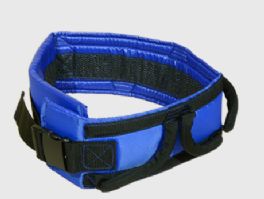 | Handi Belt Patient Maneuverability Gait Belt View Product |
Gait belts are the unsung hero of patient transfer and mobility devices. This humble device resembles a typical belt and can be made out of many different materials and come in different sizes. What these belts offer users and caregivers alike, is invaluable -- freedom from awkward grips or insufficient hand-holding. The gait belt allows the caretaker or clinician to have something to hold while assisting the wearer during transfer.
Gait belts are typically padded for comfort, made of durable synthetic fabrics, and equipped with handles around all sides. These handles make the transfer process, from bed to wheelchair for instance, much safer for the patient and for the caretaker. These belts are best suited for patients who have some degree of lower body strength and are cooperative. This is due to the fact that some help from the patient is necessary for use of the gait belt to be successful.
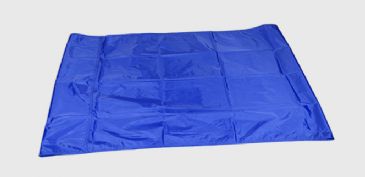 | Patient Transfer and Re-positioning Sheets View Product |
Sometimes the situation calls for a more portable solution than a lift can accommodate. This is where miscellaneous sliding transfer aids are a great solution. These products come in many shapes and sizes, but they all help users to reduce friction and ‘slide’ from one place to the next.
One very common design here is ultra-smooth plastic sheets. The durable material is designed to slide over. If the sheet is positioned under the user in their wheelchair, caretakers on either side can lift the sheet to the side of the bed and slide the user gently to safety.
By using transfer sheets to allow a smooth ride onto the bed or for repositioning, caretaker strain can actually be greatly reduced. While this might not be an all-encompassing solution for home use, it is certainly helpful during travel or in addition to other lifts and mobility aids. Bestcare’s transfer sheets are available in three sizes to suit all users.
Aging at home doesn’t have to mean renovating your whole life. Mobility challenges come with getting older, but fortunately, companies like Bestcare exist to help make sure that you and your loved ones can focus on more important things than just getting around the house.
Boasting a full line of powerful lifts, comfortable and supportive slings, and ingenious transfer aids, it is safe to say that Bestcare knows mobility devices. They have been in the business for more than 30 years and bring that experience to all of their products available today.
If you or your family member are in need of a patient transfer solution-- whether that is a full hydraulic lift or simply a slippery sheet -- consider looking into the great products on offer from Bestcare. View our entire list of products HERE!

Co-Founder of Rehabmart and an Occupational Therapist since 1993. Mike has spent his professional career working in multiple areas of Occupational Therapy, including pediatrics, geriatrics, hand therapy, ergonomics and inpatient / outpatient rehabilitation. Mike enjoys writing articles that help people solve complex therapeutic problems and make better product choices.